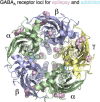Ionotropic GABA and Glutamate Receptor Mutations and Human Neurologic Diseases
- PMID: 25904555
- PMCID: PMC4468639
- DOI: 10.1124/mol.115.097998
Ionotropic GABA and Glutamate Receptor Mutations and Human Neurologic Diseases
Abstract
The advent of whole exome/genome sequencing and the technology-driven reduction in the cost of next-generation sequencing as well as the introduction of diagnostic-targeted sequencing chips have resulted in an unprecedented volume of data directly linking patient genomic variability to disorders of the brain. This information has the potential to transform our understanding of neurologic disorders by improving diagnoses, illuminating the molecular heterogeneity underlying diseases, and identifying new targets for therapeutic treatment. There is a strong history of mutations in GABA receptor genes being involved in neurologic diseases, particularly the epilepsies. In addition, a substantial number of variants and mutations have been found in GABA receptor genes in patients with autism, schizophrenia, and addiction, suggesting potential links between the GABA receptors and these conditions. A new and unexpected outcome from sequencing efforts has been the surprising number of mutations found in glutamate receptor subunits, with the GRIN2A gene encoding the GluN2A N-methyl-d-aspartate receptor subunit being most often affected. These mutations are associated with multiple neurologic conditions, for which seizure disorders comprise the largest group. The GluN2A subunit appears to be a locus for epilepsy, which holds important therapeutic implications. Virtually all α-amino-3-hydroxy-5-methyl-4-isoxazolepropionic acid receptor mutations, most of which occur within GRIA3, are from patients with intellectual disabilities, suggesting a link to this condition. Similarly, the most common phenotype for kainate receptor variants is intellectual disability. Herein, we summarize the current understanding of disease-associated mutations in ionotropic GABA and glutamate receptor families, and discuss implications regarding the identification of human mutations and treatment of neurologic diseases.
Copyright © 2015 by The American Society for Pharmacology and Experimental Therapeutics.
Figures






References
-
- Adams DR, Yuan H, Holyoak T, Arajs KH, Hakimi P, Markello TC, Wolfe LA, Vilboux T, Burton BK, Fajardo KF, et al. (2014) Three rare diseases in one Sib pair: RAI1, PCK1, GRIN2B mutations associated with Smith-Magenis syndrome, cytosolic PEPCK deficiency and NMDA receptor glutamate insensitivity. Mol Genet Metab 113:161–170. - PMC - PubMed
-
- Ahmad Y, Bhatia MS, Mediratta PK, Sharma KK, Negi H, Chosdol K, Sinha S. (2009) Association between the ionotropic glutamate receptor kainate3 (GRIK3) Ser310Ala polymorphism and schizophrenia in the Indian population. World J Biol Psychiatry 10:330–333. - PubMed
-
- Akazawa C, Shigemoto R, Bessho Y, Nakanishi S, Mizuno N. (1994) Differential expression of five N-methyl-D-aspartate receptor subunit mRNAs in the cerebellum of developing and adult rats. J Comp Neurol 347:150–160. - PubMed
-
- Andreoli V, De Marco EV, Trecroci F, Cittadella R, Di Palma G, Gambardella A. (2014) Potential involvement of GRIN2B encoding the NMDA receptor subunit NR2B in the spectrum of Alzheimer’s disease. J Neural Transm 121:533–542. - PubMed
Publication types
MeSH terms
Substances
Grants and funding
LinkOut - more resources
Full Text Sources
Other Literature Sources
Medical
Miscellaneous

